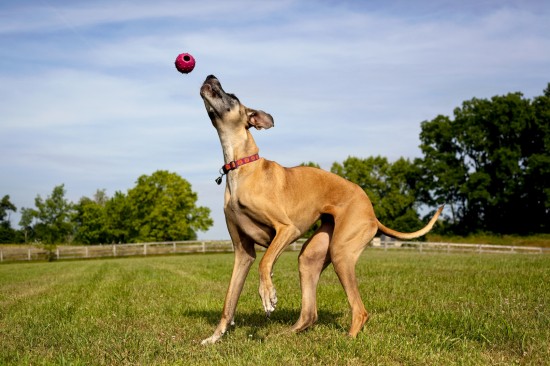

Some dogs are naturally much more lively, excitable and full of beans than others, and this can sometimes manifest as hyperactive behaviour. While ensuring that your dog gets enough exercise and stimulation can help to keep high energy levels manageable, this is not always sufficient, and owning and caring for a hyperactive dog on a daily basis can prove very challenging. Dogs of this type are often very single minded, and can prove obsessive about things, such as getting their own way or finding something to do! The same can be true of dominant dogs, and there is a reasonable amount of crossover between dominant behaviour and hyperactive behaviour, but these two different traits should not be lumped together as standard.
If your dog is one track minded, very hyperactive or demanding and likes to get their own way, don’t despair! In this article, we will look at the similarities and differences between hyperactive behaviour and dominance, plus how to tackle them.
A hyperactive dog is one that is both full of boundless energy and rather obsessive about things, such as a dog that will happily chase and retrieve a ball for hours on end, beyond the point of tiredness. These are the type of dogs that will enjoy an active, lively two hour walk, and appear to be as fresh when they come back as when they went out! They also tend to have a poor attention span when not feeling stimulated enough.
Dogs with high intelligence, boundless energy and sometimes obsessive or strongly instinctive personalities often hail from the working dog groups, such as the Border Collie, other herding dogs, working spaniels, and sled dogs such as the Siberian Husky.
True dominance involves the drive to be head of the pack, and this is something that is more situational than based upon an inbuilt personality trait. A dog may appear to be subordinate to one handler but display dominance with another, which largely comes down to the handling and relationship each person builds up with the dog, and how they manage them.
Dominance is fluid, and in any pack or group situation involving dogs or dogs and humans, one party will naturally segue into the role of the alpha. If your dog is not properly trained and taught to respect you and your position above them, any dog may naturally simply step into the alpha role themselves.
It is all too easy to describe a set of behaviours as wilful disobedience or dominance, when in fact your dog is just acting in a manner that has previously paid off for them, or they have received what they perceive to be approval or reinforcement of it.
For instance, if your dog is prone to barking and making a lot of noise for attention, this is often thought of as dominance and a demanding behaviour, whereas to your dog, they have likely simply learned that if they bark and make a fuss they can reliably get your attention, providing a positive pay off for their actions.
Dogs that display hyperactive behaviour are likely to be dogs who have been used to keeping busy and receiving plenty of stimulus, which get easily bored when their natural need for novelty, exercise and mental stimulation are not met. This leads to frustration and excessive energy levels, which mean that your dog will develop a one track mind or a short attention span, and spend their waking hours doing everything in their power to find something to do.
Dogs that are perceived to be dominant, on the other hand, are likely to be dogs who have simply received a payoff for their supposedly dominant actions in the past, and are repeating it; such as the case with the barking and reinforcement outlined above.
There are several shared traits between dominant and hyperactive behaviour, and often (but not always) the two things will go hand in hand. A dog that is hyperactive is likely to be very demanding of your attention and interaction with them, as will dominant dogs, both failing to take cues from you about when it is not appropriate to be underfoot and demanding play or feedback.
Pawing at you, jumping at you and forcing toys onto you in an attempt to get you to play can all be either dominant or hyperactive traits, with the end goal being to receive positive feedback and get something that the dog wants.
In order to deal with either issue or a combination of both, you should take a two-pronged approach to the problem. First of all, ensure that your dog receives enough attention, stimulation and exercise to fulfil their needs; and secondly, work on re-wiring your dog’s thought processes to provide positive feedback for good actions, and no reinforcement for bad ones.
This means not giving in to the demanding dog, or rewarding them with attention simply to get them to stop when they become really annoying! Keep your dog busy, let them wear themselves out, and then go back to basics with some simple training commands to teach your dog again about what behaviour is acceptable, and in what situation.
Copyright © 2005-2016 Pet Information All Rights Reserved
Contact us: www162date@outlook.com